 Image search results - "noto" Image search results - "noto" |

The Higashi-Omi Giant Kite Festival (Higashi-Omi Odako Matsuri) is held on the last Sunday of May at Fureai Undo Park (ふれあい運動公園) in Notogawa, HigashiOmi, Shiga. The main highlight is the giant kite, flying at 11:30 am and 2:30 pm.My video of the Higashi-Omi Giant Kite Festival on May 26, 2013. Due to a tragic kite crash in May 2015, this kite festival has been suspended since May 2016. It will not be held in May 2019 either.
|
|
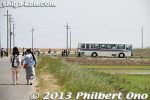
Also see kite-flying contests, exotic kites from around Japan, and stage entertainment. Anybody can fly a kite too. From 10 am to 3 pm.
|
|

Free shuttle buses ran from JR Notogawa Station to the park which had no public parking.
|
|
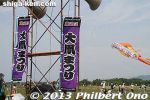
The festival name changed from Yokaichi Odako Matsuri to Higashiomi Odako Matsuri in May 2012 and the festival site changed in May 2013 to Fureai Undo Koen Park. Map
|
|
|
|
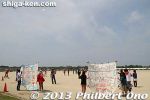
Kite-flying contest.
|
|
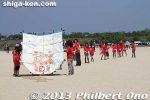
The kites are the size of two tatami mats.
|
|
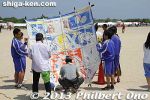
About 30 teams competed in kite-flying and design contests.
|
|
|
|
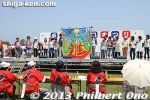
Thirty teams made "mini giant kites" and competed in kite design (図柄) and flying (飛揚). They went on the outdoor stage for kite design judging.
|
|
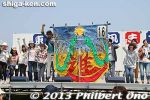
This team is from Higashi-Omi City Hall's young employees group.
|
|
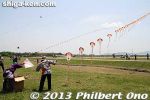
Kite trains (連凧) are the crowd favorite.
|
|
|
|
|
|
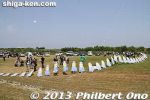
Then I stumbled across this arch kite.
|
|
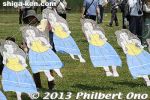
To my delight, it was an arch kite of hula girls.
|
|
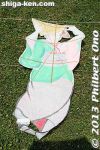
The hula girls were joined by Awa Odori girls from Tokushima.
|
|
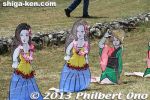
They're even wearing a lei and a flower in their hair!!
|
|
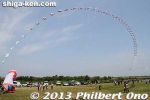
Huge arch kite of hula girls and Awa Odori dancers.
|
|
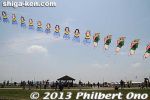
Needless to say, this was my favorite kite at the festival. How did they know someone from Hawaii was coming?
|
|
|
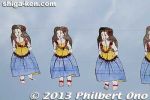
Their feet fluttered in the wind and their hips rocked left and right like real hula dancers.
|
|
|
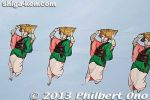
The Awa Odori dancers also danced great in the wind. (Watch my video.)
|
|
|

Hiko-nyan (Hikone Castle's official mascot) meets hula girls!
|
|
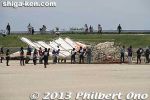
At sround 11:30 am, they cleared the area and brought out the giant kite (odako).
|
|
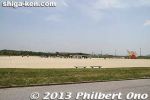
They were going to pull the kite across the width of the park since the way blew that way.
|
|
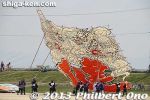
Made of washi paper (from Mino, Gifu) and a bamboo frame, the giant kite measures 13 meters high and 12 meters wide and weighs 700 kg.
|
|

The kite is unique for its cutout and hanjimon (判じもん) design.
|
|
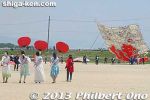
The hanjimon (判じもん) kite design always has a twin pair of creatures and a large kanji character. Together they form a thematic catch phrase.
|
|

This kite's hanjimon has twin dragons that can be pronounced "shin-shin" (辰辰), a homonym for mind and body (心身). And the vermillion kanji reads "sukoyaka" (健やか), meaning good health. So the kite wishes for your "
|
|
|
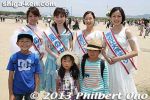
The four Wind Goddesses pose for us. The four Wind Goddesses (風の女神) are like festival princesses and they beckon the wind to blow during the kite festival.
|
|
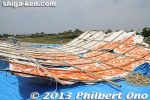
We visit the giant kite at rest. The back of the kite has many stickers written with kids' wishes.
|
|

Higashi-Omi's giant kite is a National Intangible Folk Cultural Property (選択無形民俗文化財) with a 300-year history. It started with villages flying kites for Boy's Day in May to celebrate the birth of a boy.
|
|
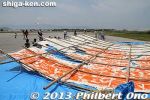
The villages then started competing in kite-making and the size grew larger and larger. The giant kite they fly today is the size of 100 tatami mats (13 m x 12 m). The Higashi-Omi Giant Kite Preservation Society (東近江大凧保存会) maintains the ki
|
|
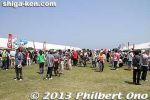
Lunch time! In the middle of the park are food booths and an entertainment stage.
|
|
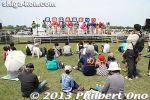
The entertainment stage provided entertainment like samba dancing and taiko drummers.
|
|
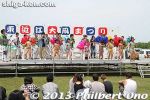
Higashi-Omi has a sizable Brazilian population.
|
|
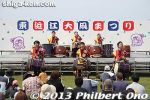
Taiko drummers.
|
|
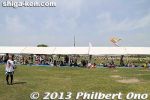
This is the first time they used this park for the festival. Closer to Lake Biwa so the wind should be stronger.
|
|
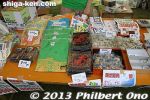
Stall selling kites. The long kite trains were sold out.
|
|
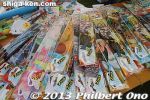
Kites for sale.
|
|
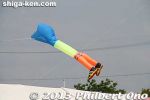
Flying trousers
|
|
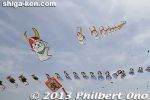
Hiko-nyan kite train and hula girl arch kite
|
|

Hiko-nyan kite train
|
|
|
|
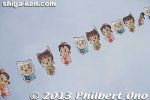
Behind Hikonyan were Nagahama's Azai sister trio (Chacha, Hatsu, and Go).
|
|
|
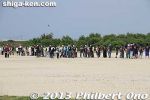
Giant kite pullers.
|
|

Wind Goddesses fanning wind the traditional way.
|
|
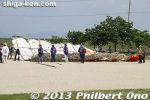
Afternoon flying session from 2:30 pm to 3 pm when the festival ended.
|
|
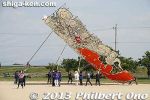
First they use long poles to prop up the giant kite.
|
|
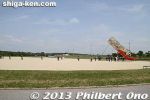
The kite pullers get ready to run. A small taiko drum beats, faster and faster.
|
|
|
|
|
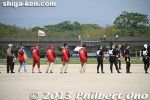
Members of the Giant Kite Preservation Society pull the front of the rope.
|
|
|
|
|
|

Around 100 people pull the giant kite. Junior high and older people can sign up to pull the kite.
|
|
|
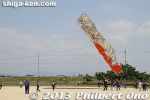
This is the last flight of several that day.
|
|
|
|
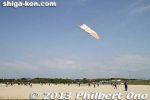
Although the kite left the ground each time, it didn't stay in the air for long.
|
|
|
|
|
|

Notogawa Station on JR Tokaido/Biwako Line. Beautifully designed station resembling a water wheel, the symbol of the town. East Exit. 能登川駅
|
|

Notogawa Station, East side
|
|

Notogawa Station, West Exit, also designed as a water wheel. This is one of Shiga's best-designed train stations. Beautifully designed station resembling a water wheel, the symbol of the town.
|
|
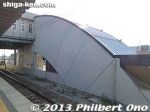
Rear view of the waterwheel station as seen from the train.
|
|
|
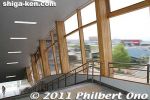
Inside Notogawa Station. The waterwheel structure houses a stairway and escalator.
|
|
|
|

Notogawa Station's west side has a shopping mall whose entrance has a waterwheel motif.
|
|
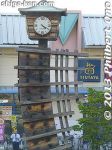
Waterwheel objects on Notogawa Station's west side.
|
|
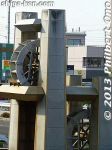
Waterwheel objects on Notogawa Station's west side.
|
|

Waterwheel objects on Notogawa Station's west side.
|
|

Notogawa in Higashi-Omi is famous for its giant water wheel. Bike path to Notogawa, another area in Shiga with a good and scenic bike path.
|
|

Cycling path in Notogawa, Higashi-Omi.
|
|

Cycling path in Notogawa, Higashi-Omi.
|
|
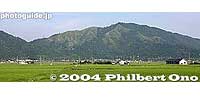
Mt. Kinugasa (Kannonji)
|
|
|

Cycling and pedestrian path in Notogawa, Higashi-Omi.
|
|

Cycling path map in Notogawa, Higashi-Omi.
|
|
|

Canoe Land
|
|

Notogawa giant water wheel in Higashi-Omi, Shiga. Map
|
|

Symbol of Notogawa
|
|
|
|
|
|
|
|
|
|
|
|

Poster for dragon canoe race in June
|
|

Uses a water wheel to grind rice.
|
|
|
|
|
|
|
|
|
|

Cycling and pedestrian path in Notogawa, Higashi-Omi.
|
|

Cycling and pedestrian path in Notogawa, Higashi-Omi.
|
|

Cycling and pedestrian path in red in Notogawa, Higashi-Omi.
|
|

Kita-ke is a district governor's residence with a 350-year history. It is now a museum exhibiting documents and artifacts of its past. The house and front gate (photo) are National Important Cultural Properties.
|
|
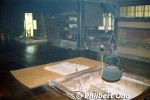
Inside Kita-ke.
|
|

Kita-ke
|
|

Near JR Menda Station.
|
|

Chirihama Nagisa Driveway is Japan's only beach where motor vehicles are permitted to run as a public thoroughfare. It extends for about 8 km.The beach is not pronounced "Senrihama."
|
|

Chirihama Nagisa Driveway in Hakui, Ishikawa is Japan's only beach where motor vehicles are permitted to run as a public thoroughfare. It extends for about 8 km. It goes parallel to another highway inland, so this beach road is more for tourists. Note that this beach may be closed to traffic in bad weather.
|
|

Even tour buses can easily drive on the beach. One of the coolest things I ever saw in Japan.Chirihama Nagisa Driveway in Hakui, Ishikawa.
|
|

The sand grains are about half the size of normal sand, resulting in a very packed and solid sandy surface. Solid enough for vehicles.Chirihama Nagisa Driveway in Hakui, Ishikawa.
|
|
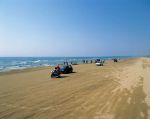
Chirihama Nagisa Driveway in Hakui, Ishikawa. You can also park your car and wade in the water.写真提供:©石川県観光連盟
|
|

Chirihama Nagisa Driveway in Hakui, Ishikawa.写真提供:©石川県観光連盟
|
|
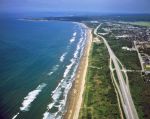
Aerial view of Chirihama Nagisa Driveway in Hakui, Ishikawa.写真提供:©石川県観光連盟
|
|

Myojoji Temple in Hakui belongs to the Nichiren Buddhist sect. It is the Nichiren headquarters temple for the Hokuriku Region. 妙成寺Myojoji Temple gate.写真提供:©石川県観光連盟
|
|

In Hakui, Ishikawa, Myojoji Temple's five-story pagoda is a National Important Cultural Property built in 1618. 妙成寺 五重塔The temple was founded in 1293 by Nichizō, a second-generation disciple of Nichiren. Some of the temple structures are National Important Cultural Properties.
|
|

In Hakui, Ishikawa, Myojoji Temple's five-story pagoda is a National Important Cultural Property built in 1618. 妙成寺 五重塔Temple address: 石川県羽咋市滝谷町ヨ1
|
|

In Hakui, Ishikawa, Myojoji Temple's Shaka Nyorai Buddha statue (釈迦如来立像) standing 5 meters high inside Jorokudo (Shakado) Hall. 丈六堂(釈迦堂)Website: http://myojoji-noto.jp/
|
|

Myojoji Temple's Main hall写真提供:©石川県観光連盟
|
|

Myojoji Temple's Main hall写真提供:©石川県観光連盟
|
|

Noto Kongo Coast stretches for 29 km, a scenic part of Noto Peninsula. 能登金剛
|
|

Ganmon Gate Rock is perhaps the most famous sight on the Noto Kongo Coast. From a nearby boat dock, see it by boat. Erosion by waves created this tunnel-like rock measuring 15 meters high, 6 meters wide, and 60 meters long. 巌門Boat cruises for Ganmon Rock costs ¥1,200. Takes only 20 min.
http://www.ganmon.jp/
|
|

Ganmon Gate Rock is the most noted natural formation on the Noto Kongo Coast. 巌門
|
|

Ganmon Gate Rock as seen from a boat cruise. 巌門
|
|

Noto Kongo Coast 能登金剛
|
|

Hatago Iwa wedded rocks are another noted natrual feature on the Noto Kongo Coast. A legend about the Hataori god (機織りの神様) happened here. 機具岩 (Noto Futami)
|
|

Hatago Iwa wedded rocks "Hatago" is a tool for weaving. 機具岩 (Noto Futami)
|
|

Hatago Iwa wedded rocks. The larger, female rock (with the hole) stands 16 meters high and has a small shrine. Smaller male rock is 12 meters high. The Kongo Coast sure has lots of rocks with a hole in them. 機具岩 (Noto Futami)写真提供:©石川県観光連盟
|
|
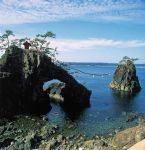
Hatago Iwa wedded rocks are nicknamed "Noto Futami" (能登二見) because they are similar to the famous wedded rocks in Futami, Mie Prefecture. 機具岩写真提供:©石川県観光連盟
|
|

Hatago Iwa wedded rocks face west, so it's great for sunsets. 機具岩写真提供:©石川県観光連盟
|
|

Sekinohana is very scenic where you can walk around on a cliff overlooking the ocean. 関野鼻
|
|

Sekinohana 関野鼻
|
|

Sekinohana 関野鼻
|
|

Senmaida in Shiroyone, Wajima is one of Japan's most famous terraced rice paddies. It's in a remote location (10 km from central Wajima), but very picturesque with the ocean (Sea of Japan) right below it. Senmaida literally means "One-thousand rice terraces."
|
|

The smallest rice terace is only 0.2 sq. meter. The land is very fertile and minimal fertilizer is required. Senmaida is one of the most picturesque and impressive spots on the Noto Peninsula.Address: 石川県輪島市白米町99-5
|
|

Volunteers plant and harvest the rice here. The rice paddies are owned by multiple owners who meet ownership requirements.
|
|

Designated as Globally Important Agricultural Heritage Systems (GIAHS).
|
|
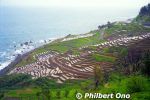
From Kanazawa Station, there are buses that go to Senmaida. Takes about 2 hours.
|
|
|
|
|
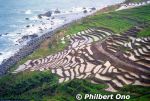
http://senmaida.wajima-kankou.jp/
|
|

写真提供:©石川県観光連盟
|
|

写真提供:©石川県観光連盟
|
|

写真提供:©石川県観光連盟
|
|

写真提供:©石川県観光連盟
|
|

写真提供:©石川県観光連盟
|
|

写真提供:©石川県観光連盟
|
|

写真提供:©石川県観光連盟
|
|

Senmaida in fall.写真提供:©石川県観光連盟
|
|
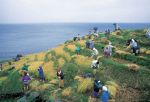
At Senmaida, harvesting rice.写真提供:©石川県観光連盟
|
|
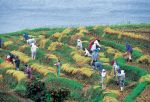
At Senmaida, harvesting rice.写真提供:©石川県観光連盟
|
|
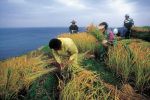
At Senmaida, harvesting rice.写真提供:©石川県観光連盟
|
|

Senmaida with candlelights during an event.写真提供:©石川県観光連盟
|
|
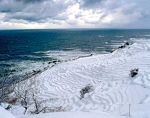
Senmaida in winter.写真提供:©石川県観光連盟
|
|

Wajima Asa-ichi Morning Market is quite famous in Noto Peninsula. Supposed to tbe one of Japan's Big Three Morning Markets. Originated in Heian Period. 輪島朝市
|
|

Wajima Asa-ichi Morning Market is held from 8 am to noon, closed on the 2nd Mon. and 4th Wed. of the month. Neither grand nor extraordinary, it is just a small street lined with stalls selling fruits, vegetables, seafood, and crafts.輪島朝市
|
|

Wajima Asa-ichi Morning Market sells lots of stuff including seafood. 輪島朝市Address: 石川県輪島市河井町朝市通り
Website: https://asaichi.info/
|
|
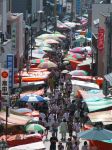
Wajima Asa-ichi Morning Market 写真提供:©石川県観光連盟
|
|
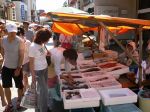
Wajima Asa-ichi Morning Market has lots of seafood.写真提供:©石川県観光連盟
|
|

Wajima Asa-ichi Morning Market 写真提供:©石川県観光連盟
|
|
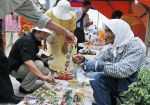
Wajima Asa-ichi Morning Market 写真提供:©石川県観光連盟
|
|

Wajima Asa-ichi Morning Market 写真提供:©石川県観光連盟
|
|

Wajima-nuri Kaikan (Wajima Lacquerware Hall 輪島塗会館). Making Wajima-nuri lacquerware (urushi). Wajima-nuri is very famous and the lacquer is known to be very durable. 輪島塗
|
|

Wajima-nuri lacquerware has been around for centuries. It is known to be high-end and expensive lacquerware. 輪島塗
|
|

Wajima has many nice lacquerware shops. Walk around town and drop in to see the fine lacquerware for sale. You will gasp at some of the prices. (A pair of lacquered chopsticks can cost ¥20,000.) 輪島塗
|
|

It is said that Wajima lacquerware dates back some 1,000 years. It takes 75 to 124 meticulous steps to produce Wajima lacquerware. 輪島塗There are four basic stages: Procuring and preparing the wood, shaping the wood into the desired form, lacquering, and decoration.
|
|
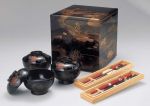
Wajima-nuri lacquerware写真提供:©石川県観光連盟
|
|
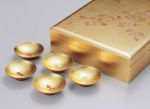
Lacquerware with gold leaf.写真提供:©石川県観光連盟
|
|
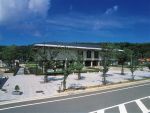
Wajima Museum of Urushi Art is the only museum in Japan specializing in lacquerware. Besides Wajima-nuri, it also shows lacquerware from other parts of Japan. 石川県輪島漆芸美術館https://www.city.wajima.ishikawa.jp/art/
写真提供:©石川県観光連盟
|
|
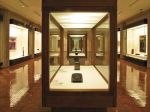
石川県輪島漆芸美術館写真提供:©石川県観光連盟
|
|

Sodegaura is a scenic place to stroll around. 鴨ヶ浦
|
|

Sodegaura 鴨ヶ浦
|
|

Sodegaura 鴨ヶ浦
|
|

Washing fishing boat at Wajima port.
|
|

Wajima Kiriko Art Museum exhibits floats from the Noto Kiriko Matsuri. Kiriko are tall lanterns. The festival is held in many locations on the Noto Peninsula during July to Oct. 輪島キリコ会館Address: 石川県輪島市マリンタウン6-1
Open 8 am–5 pm
Admission charged.
|
|

Wajima Kiriko Art Museum. Kiriko lantern floats can be as tall as 15 meters and weigh 2 tons. They are pulled around town. 輪島キリコ会館https://wajima-kiriko.com/en/
|
|
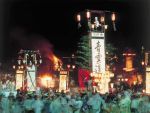
Wajima Taisai Festival with kiriko floats. Wajima has four kiriko festivals. Most kiriko lantern festivals in the Noto Peninsula are held at night. 輪島大祭https://www.hot-ishikawa.jp/kiriko/en/kiriko/wajimataisai.php
写真提供:©石川県観光連盟
|
|
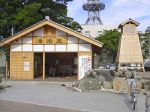
Wajima onsen foot bath.写真提供:©石川県観光連盟
|
|
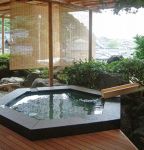
写真提供:©石川県観光連盟
|
|

Gojinjo-Daiko is powerful, crazied drumming performance by several men donning demon masks and wigs. They are based in a small village called Nabune in Wajima where Gojinjo-daiko originated.Legend has it that their drumming and fierce-looking masks drove off the invading forces of Uesugi Kenshin, ruler of Echigō Province (Niigata Pref.) during the Warring States Period in the 16th century.
写真提供:©石川県観光連盟
|
|

Old Wajima Station before it closed in 2001 when the Noto Railway line between Wajima and Anamizu Stations was abolished. It's now a Michi-no-Eki Wajima Roadside Station selling local produce.
|
|
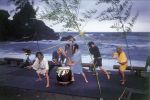
The taiko drummers wear fearsome masks while drumming. Gojinjo daiko commemorate the day when villagers in Nabunemachi in Wajima, Ishikawa Prefecture used crude and frightening masks made of tree bark and seaweed dangling from their heads.写真提供:©石川県観光連盟
|
|
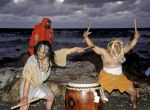
They beat taiko drums when they invaded Lord Uesugi Kenshin's base camp. They used sickles and hoes to chase away the army who was enroute to capture Nanao Castle. The villagers lived happily afterward.写真提供:©石川県観光連盟
|
|
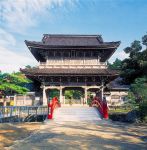
Sojiji Soin Temple in Wajima used to be one of the headquarters temple for the Soto Zen Buddhist sect until a fire razed most of the temple in 1898. 總持寺祖院This is the Sanmon Gate.
写真提供:©石川県観光連盟
|
|
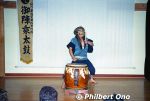
They also perform indoors for free on weekend evenings (or every evening in summer) at Wajima Kiriko Art Museum.
|
|
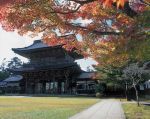
The new headquarters temple was transferred to the one in Yokohama in 1911. Sojiji Soin Temple is now a regional headquarters temple (betsuin).写真提供:©石川県観光連盟
|
|

Gojinjo-Daiko drummers.
|
|

Sojiji Soin Temple.写真提供:©石川県観光連盟
|
|
|
|
|
|
|
|
|
|
|
|
|
|
|
|
|
|

Old video of gojinjo-daiko drummers performing in Wajima.
|
|
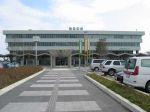
Noto Airport写真提供:©石川県観光連盟
|
|
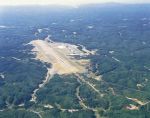
Noto Airport写真提供:©石川県観光連盟
|
|

Two Tokikuni-ke (¥520) thatched-roof homes in Sosogi. Built in 1831, Kami Tokikuni-ke was the residence of a wealthy farmer descended from Tokikuni who was related to the Taira Clan. The house has stately rooms and a garden. 上時国家写真提供:©石川県観光連盟
|
|

Kami Tokikuni-ke home. Both Tokikuni-ke homes are National Important Cultural Properties.
|
|

Inside Kami Tokikuni-ke home.写真提供:©石川県観光連盟
|
|

Inside Kami Tokikuni-ke home.
|
|

Tokikuni-ke home.写真提供:©石川県観光連盟
|
|

A short walk away is the less grand Shimo-Tokikuni-ke, the residence of a branch family of the Tokikuni. 下時国家
|
|

In Wajima, Sosogi Coast is a National Place of Scenic Beauty with craggy and unusual rock formations. Sights include Window Rock (Mado-iwa) here. 窓岩Location: https://goo.gl/maps/KJcj2X6BmeETgTE57
|
|
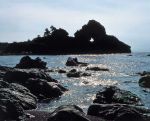
Mado-iwa (Window Rock) has a through hole in the rock. Rough waves have eroded the Sosogi Coast into fantastic rock formations largely made of rhyolite.写真提供:©石川県観光連盟
|
|

Tarumi Falls flow directly into the ocean. 垂水の滝Sosogi Coast in Wajima is a scenic area of craggy and unusual rock formations. Sights include Window Rock (Mado-iwa) and Tarumi Falls.
|
|

In winter, strong winds blow Tarumi Falls upward so much that the water does not fall into the plunge pool. 垂水の滝Location: https://goo.gl/maps/WLYQ6LZaHR8E9h9d9
|
|
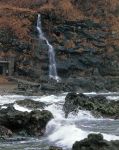
Tarumi Falls 垂水の滝写真提供:©石川県観光連盟
|
|
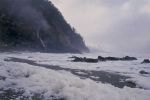
In winter, the Sosogi Coast is famous for Nami-no-Hana (wave flowers) which are bits of ocean foam that get blown around in the air like flowers.写真提供:©石川県観光連盟
|
|
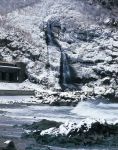
Tarumi Falls in winter. 垂水の滝写真提供:©石川県観光連盟
|
|
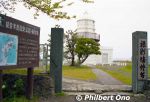
Rokkosaki Lighthouse is on the northern tip of Noto Peninsula in Ishikawa Prefecture. Built in July 1883 and designed by a British engineer named Richard Henry Brunton. It is also pronounced "Rokkozaki."Richard Henry Brunton (1841–1901) came to Japan in July 1868 to design lighthouses. He designed 26 lighthouses in Japan and was dubbed "Father of Japanese lighthouses".
|
|
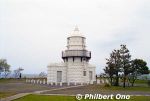
Rokkosaki Lighthouse is unmanned and normally closed to the public. A few times a year, it's open to the public. Stands on a cliff 50 meters above the sea.Many boats got lost or shipwrecked in this area until a bon fire was kept lit at night from the 18th century before this lighthouse was built. The light was first fueled by oil, then electricity in 1940.
|
|
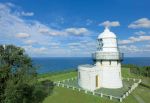
It took 2 years to build Rokkozaki Lighthouse. Made of highly durable stones hauled in 60 km by boat from Anamizu. From the boat, the stones were carried up the high cliff on a cable system.The lighthouse became automated (unmanned) in 1963. After over a century, this lighthouse still stands and operates. The light is visible for 33 km at sea.
写真提供:©石川県観光連盟
|
|

Cape Rokkosaki is at the northernmost tip of Noto Peninsula and famous as where you can see both the sunrise and sunset over the ocean.On clear days, Sado island in Niigata Prefecture can also be seen.
Address: 石川県珠洲市狼煙町イ-51
|
|

Marker for "Center of the Japanese Archipelago" near Rokkosaki Lighthouse.
|
|

Nicknamed "Battleship Island" (Gunkanjima), Mitsukejima island is Suzu's most famous attraction about 200 meters from shore. 見附島"Mitsukejima" means "Found Island," supposedly named by the priest Kukai (Shingon Buddhist sect founder) when it was the first island that he "found" on his way back from Sado island in Niigata. It was also "found" by a deity who descended here.
写真提供:©石川県観光連盟
|
|

Made of white, diatomite rock, Mitsukejima island is 150 meters long, 50 meters wide, 28 meters high, and a perimenter of 400 meters, capped with Japanese pine trees. Free admission.写真提供:©石川県観光連盟
|
|
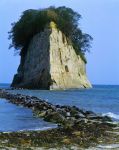
Mitsukejima island has a rock bridge for easy access. There's Mitsuke Shrine and wild birds like crows and cormorants. Uninhabited by humans.写真提供:©石川県観光連盟
|
|
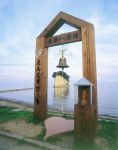
Lover's bell at Mitsukejima. The nearby beach has a swimming beach park, rest house, and camping grounds. Accessible by local bus from Wajima and Kanazawa.写真提供:©石川県観光連盟
|
|

Kihe'e-don is the former residence of the Sakurai family who engaged in salt and lacquer production. The "don" is the highest honorific in the Noto dialect. 喜兵衛どんBuilt in the mid-Meiji Period, it is a museum which attempts to show how the upper-class farmers of that time lived.
|
|
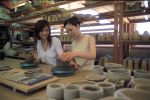
珠洲市陶芸センター写真提供:©石川県観光連盟
|
|
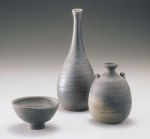
Suzu pottery写真提供:©石川県観光連盟
|
|
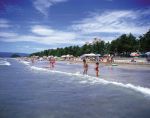
Hachigasaki Beach 鉢ヶ崎海水浴場写真提供:©石川県観光連盟
|
|
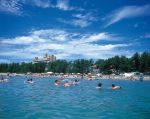
Hachigasaki Beach 鉢ヶ崎海水浴場写真提供:©石川県観光連盟
|
|
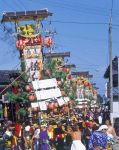
Takojima Kiriko Festival held in autumn in Suzu. Floats have lots of lacquered parts. 蛸島キリコ祭りhttps://www.hot-ishikawa.jp/kiriko/en/kiriko/takojima.php
写真提供:©石川県観光連盟
|
|

Bentenjima island on the Koiji Coast that stretches for 1 km. It's a lover's beach because "Koiji" means "lovers' road." It comes from a lovers' tragedy legend. Lots of couples come here. 恋路海岸 弁天島In the foreground is a Kannon statue. 恋路観音像
|
|
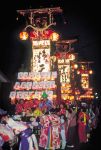
Takojima Kiriko Festival in Suzu. 蛸島キリコ祭りhttps://www.hot-ishikawa.jp/kiriko/en/kiriko/takojima.php
写真提供:©石川県観光連盟
|
|
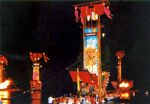
Hôryu Tanabata Kiriko Festival held on Aug. 7 in Suzu. 宝立七夕キリコ祭https://www.hot-ishikawa.jp/kiriko/en/kiriko/houryu.php
写真提供:©石川県観光連盟
|
|
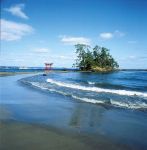
Bentenjima island on the Koiji Coast. Benten or Benzaiten is the goddess of music and water and anything that flows. The beach is popular with swimmers in summer.写真提供:©石川県観光連盟
|
|

Koinobori carp streamers.
|
|

Tsukumo Bay is a ria or coastal inlet. Boat cruises are available. 九十九湾写真提供:©石川県観光連盟
|
|
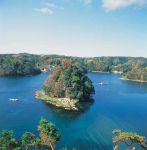
Tsukumo Bay has this island called Horaijima. 蓬莱島 九十九湾写真提供:©石川県観光連盟
|
|
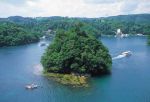
Tsukumo Bay 九十九湾写真提供:©石川県観光連盟
|
|

Tsukumo Bay 九十九湾写真提供:©石川県観光連盟
|
|

Tsukumo Bay 九十九湾写真提供:©石川県観光連盟
|
|
|
|